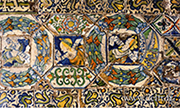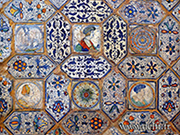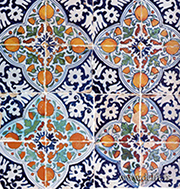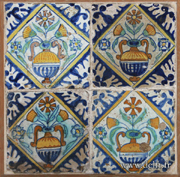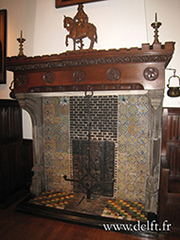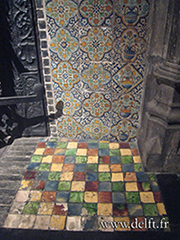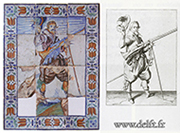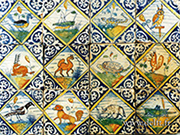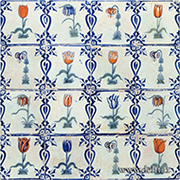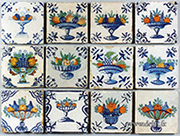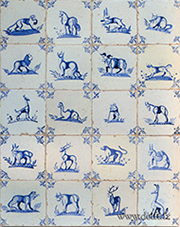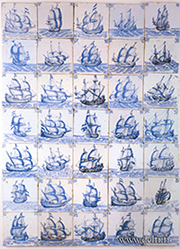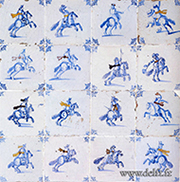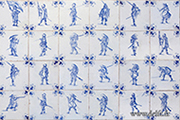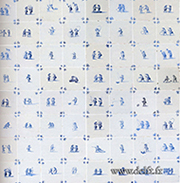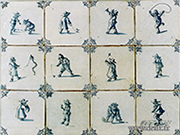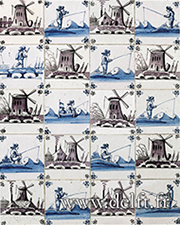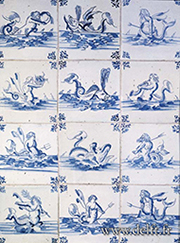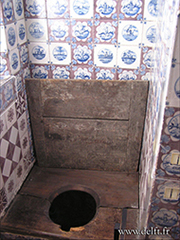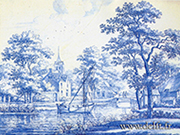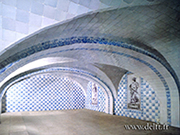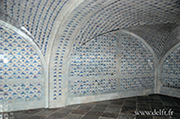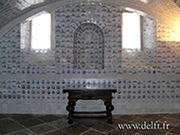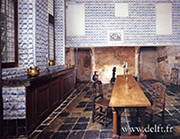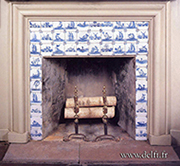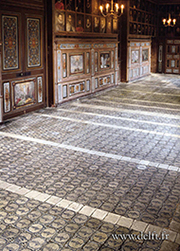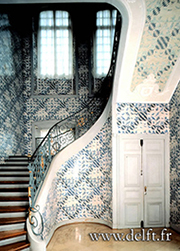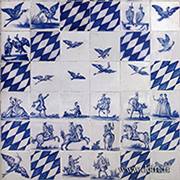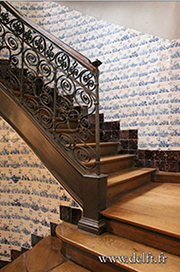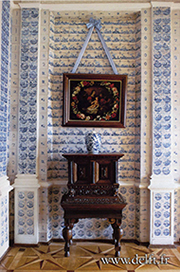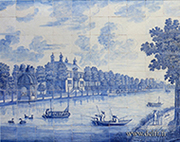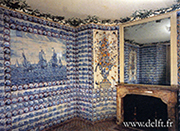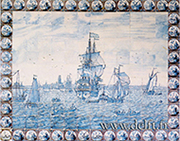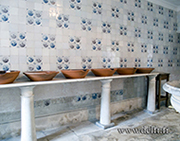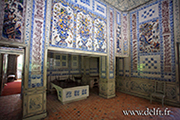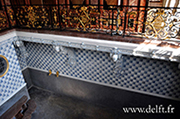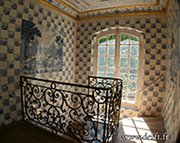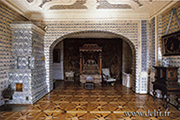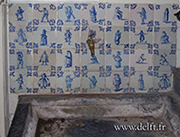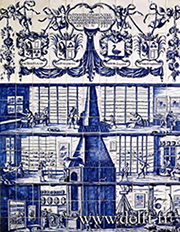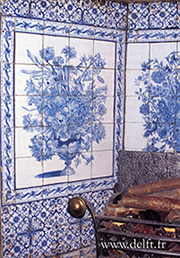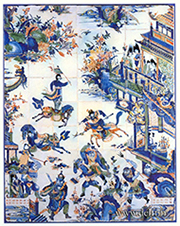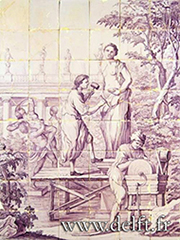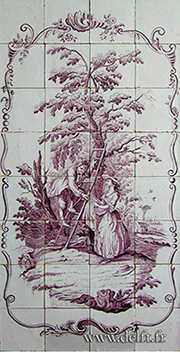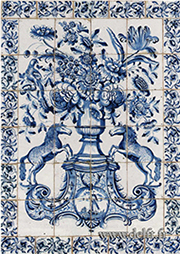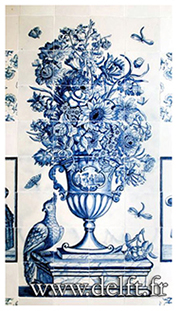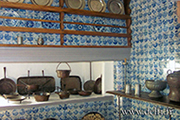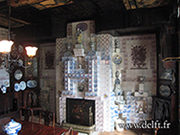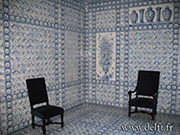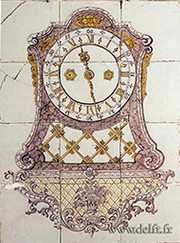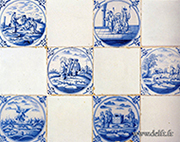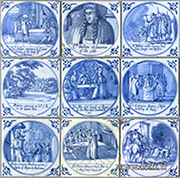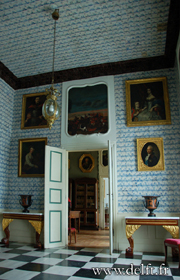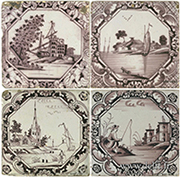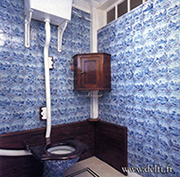
History of Dutch tiles
See our gallery of Delft tiles
From Italy to Antwerp
Around 1500, three Italian potters moved to Antwerp. They were painters of maiolica, the famous tin-glazed pottery of the Italian Renaissance, an earthenware with bright colours, frequently depicting historical and legendary scenes. The city of Antwerp, located on the estuary of the Scheldt river, was already one of the leading seaports of Europe. This city was also becoming a great cultural and artistic centre. The most famous of these three Italian artisans was Guido di Savino, known in Antwerp as Guido Andries. Native to Castel Durante (Duchy of Urbino), Andries learned his craft of painting ceramic wares in the Venetian workshops. He will go on to train his sons and other local potters to the Italian majolica technique. He teaches them how to manufacture, glaze, and paint all kind of ceramic wares: not only tableware, apothecary jars, maiolica chargers, but also tile panels and tiles for floorings. Enthusiasm for these vivid maiolica pavement is great; Andries and his sons are commissioned to create tiles for stately homes, castles, and abbeys in Flanders, England and France.
From Antwerp to the United Provinces
In 1576, Antwerp was looted by mutinying Spanish soldiers. Later on, in 1585, the city was besieged and seized by the Habsburg. Many of the city's potters took refuge further north, in the so-called United Provinces taking with them their savoir-faire. Ceramic workshops and studios then flourished in Haarlem, Utrecht, Amsterdam, Rotterdam, and of course, in most famously Delft. It is this small town that finally will give its name to the production of ceramic ware, pottery, and tiles, made throughout the area: Delftware. Once independence was gained from the Habsburgs during the 17th century, the ceramic tile industry experiences considerable growth thanks to the reconstruction of cities. Tiles have indeed a great advantage from a practical, hygienic and aesthetic point of view, and are then incorporated into every part of this grand reconstruction.
Fighting against the made in China
Production of earthenware glazed ceramics also helped competing Chinese porcelain. Chinaware was massively imported by the Dutch East India Company, whose headquarters is precisely in the port of Delft. It is under the influence of Chinese porcelains that local potters will start painting blue and white ceramic pieces and tiles. Throughout the 17th and the 18th centuries, kings and aristocrats will ornate their palaces throughout Europe with Dutch earthenware tiles. The demand is very high and the Netherlands become major producers and exporters of glazed tiles. They will decorate walls and façades in Versailles ("Trianon de Porcelaine"), Munich (Nymphenburg Palace), Saint Petersburg (Menshikov Palace), and in Portugal. In this country, as in Spain, tiles known as azulejos have been commonly used to ornate walls and floorings since the Moorish period (see: www.azulejos.fr). Portuguese aristocrats started commissioning tile panels from Dutch tile studios in the late 17th century. Two Dutch faience painters, Willem van der Kloet and Jan van Oort, will eventually settle in Portugal to answer numerous local commissions. It is under this influence, that Portuguese azulejos became mostly blue and white during the 18th century.
Delft tile: a generic name
As a result of this success, imitations of Delft tiles began to be manufactured in Germany, England, Belgium, and northern France. Thus, the term "Delft tile" refers more to a style than to an origin, because ultimately only very few of these tiles were produced in Delft itself. Each European language has a similar expression: carreaux de Delft (French), Delft fliesen (German), azulejos de Delft (Spanish and Portuguese), Delftse tegels (Dutch), piastrelle di Delft (Italian), kafle z Delft (Polish), Delft klaken (Swedish), πλακάκια Delft (Greek), Делфт Плитка (Russian)... The name "Delft" also remains attached to blue colour, chosen to imitate Ming porcelain, and used as a single tone. The most famous painter from Delft is Frederik van Frytom (1632-1702) who decorated wall plaques with extremely fine landscapes in blue shades. Although other colours have been used according to the times, Delft remains for many associated with blue. Delft tiles are characterized by their ornamental composition. The simplest are a central motif, framed in the angles by 4 corner motifs. The main themes are landscapes, boats, biblical scenes, characters, childrens' games, flowers, animals... Workshops in Rotterdam such as Jan Aalmis (1674-1755) or Cornelis Boumeester (1652 - 1733) have also produced ceramic panels on a larger scale representing marine scenes, landscapes, amorous or religious scenes, bouquets, etc.. The success of the "Delft" tile was so great that in the 18th century, they were used to decorate the Bardo palace in Tunis, palaces in Lisbon, and convents in Salvador de Bahia.
Gallery Delft tiles
-
Majolica tiles painted in Antwerp in 1520 for The Vyne (Tudor mansion, Hampshire, England), still in situ
-
Pavement painted in Antwerp in 1532 for the Abbey of Herkenrode (Belgium)
-
The Conversion of Saint Paul, panel painted in Antwerp in 1547; Vleeshuis Museum (Antwerp)
-
Detail of previous panel
-
Tiles decorated with grenades painted in Antwerp circa 1600
-
Tiles painted in Antwerp circa 1600
-
Museum Van den Bergh in Antwerp, the fireplace
-
Museum Van den Bergh in Antwerp, detail of the fireplace
-
Panel painted around 1610 after an engraving of Jacob De Gheyn (1565-1629)
-
Dutch tiles with multicoloured animals and angle diamond, circa 1590
-
Tulips painted on 2 tiles
-
Pomegranates and flowers painted on 4 tiles
-
Tiles with flowers framed by a pattern of balusters, circa 1630
-
Dutch tiles depicting fruit baskets, 1610-1640
-
Blue tiles, with animals, 1630-1650
-
A typical theme of Delft tiles : sea vessels, circa 1650
-
Tiles depicting soldiers inspired by a series of engravings
-
Tiles with horsemen, 1640-1680
-
Delft tiles with characters, 1620-1640
-
Delft tiles depicting children's games, 1675-1750
-
Dutch tiles decorated with children at play, 1640-1670
-
Tiles with brown mills and blue fishermen
-
Tiles decorated with sea creatures
-
Rotterdam tiles decorating the toilets of Castle Rosenborg (Copenhagen)
-
Ceramic plaque painted by Frederik van Frytom (1632-1702)
-
Vaulted cellar covered with Dutch tiles, Oranienbaum Castle (Germany)
-
Vaulted cellar covered with tiles from Utrecht, Castle Caputh, near Postdam (Germany)
-
Caputh Castle (Germany)
-
Tiles in the kitchen of the Hospice Comtesse, Lille (France), early 18th c.
-
Fireplace decorated with Delft tiles
-
Tiles with soldiers in the château de Beauregard (France, Loire valey)
-
Staircase of Falkenlust Castle, Brühl (Germany)
-
Falkenlust Castle, detail (tiles painted in Rotterdam)
-
Staircase of the Hospice Comtesse of Lille (France), covered of tiles with landscapes
-
Menshikov Palace in Saint Petersburg, entirely decorated with Dutch tiles
-
18th c. ceramic panel representing the Vecht River (Netherlands)
-
Rotterdam tiles, bathroom of Rambouillet Castle (France)
-
Panel painted by Cornelis Boumeester (1652-1733) for the château de Rambouillet (France)
-
Delft Tiles in the dairy of Dyrham Park House (England)
-
Ceramic panels of the the kitchen, Amalienburg Pavilion, Munich (Germany)
-
Pool of the Badenburg Pavilion, Nymphenburg, Munich (Germany), around 1720
-
Ceramic panel and tiles decorating the staircase of the Pagodenburg Pavilion, Munich (Germany)
-
Dutch tiles painted for the Menshikov Palace, Varvara's bedroom (Saint-Petersburg)
-
Blue and white Dutch tiles with various characters
-
Tile panel depicting the process used in the royal manufacture Makkum, 1757 (Rijksmuseum, Amsterdam)
-
Fireplace in John Knox House, 18th c. (Edinburg). Panel painted by Aalmis, Rotterdam
-
Chinoiserie painted in Delft in 1725
-
Tile panel painted by Jan Aalmis (1674-1755), in Rotterdam
-
Ceramic panel with gallant scene
-
Tile panel with a bouquet
-
Tile panel decorated with a bouquet painted in Rotterdam, Augustusburg (Germany)
-
Kitchen tiles, Peterhof Palace, Saint-Petersburg
-
Glazed tiles in the home of Victor Hugo in Guernsey
-
Tartar tent, château de Groussay (France). Delft tiles painted in 1960 for Charles de Beistegui (1895-1970)
-
Trompe-l'oeil clock painted on tiles
-
Detail of the tiles, Oranienbaum Castle (Germany)
-
Historiated tiles painted in England around 1680
-
Nieborow Palace (Poland) decorated with 10.000 Dutch ceramic tiles produced in Harlingen in the 18th c.
-
Tiles painted in Liverpool (England)
-
Blue lavatory of Commissioner's house, Chatham Dockyard (Kent), with English tiles of ca 1720





